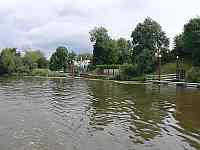
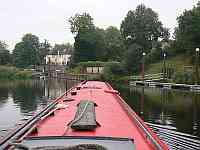
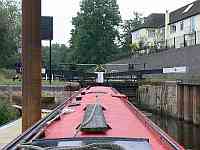
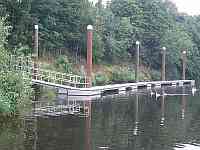
| Go to Allan's Page | Part 1 - Boston and South Kyme | Canals Home Page | Part 2 - Manchester and Gloucester | Go to Deb's Page |
Heading up through Bevere Lock above Worcester we were asked a question that we had never been asked before: "Stourport or Droitwich?" For now the Droitwich Canals had been restored and re-opened, the lock keeper needed to know which way we were going, so that he could advise the lock-keepers further upriver if we were heading their way. Not far above Bevere Lock is the entrance to the Droitwich Barge Canal which connects Droitwich to the Severn. As its name suggests, it is wide enough to take wide barges, except that the towpath through the last bridge prevents them from actually reaching Droitwich.
The restoration is an absolute triumph. It is an easy canal to travel along, and we found the locks easy to operate although naturally we met several people who complained about them (they've obviously never been across the Rochdale summit, nor even down to London on the Grand Union). Do not expect to moor along the way though, for the canal profile has always been very shallow at the edges; after all, the working boatmen had no need to moor up along the way. However there was one potential problem, where the reeds are being allowed to grow unhindered and are already taking over the navigation channel.
Arriving in Droitwich we found plenty of secure visitor mooring available on new pontoons in the middle of the town, and we spent a most enjoyable afternoon exploring the town. It is a surprisingly pretty town, well worth a visit, which has clearly realised that the reopening of the canal represents a tourist opportunity which they would otherwise lack completely; the canal has been made into a feature of the town and boating visitors are made very welcome indeed. The town betrays its origins as a salt producer (the "wich" in its name) and is reminiscent of the Cheshire salt towns like Northwich, not least in the way that subsidence has left its older buildings leaning crazily.
You leave Droitwich on a short stretch of the river Salwarpe, whose course the canal has followed since the Severn. No doubt this canalised river section will soon be softened by nature to become an attractive location but for now it still looks ugly and new. The variation in level of this section can cause problems, including flooding of the town section and possibly too little headroom to navigate the culvert underneath the M5 motorway, but in this year's dry summer we had no problems at all.
After passing under the M5, it is a steep climb up to join the Birmingham and Worcester canal at Hanbury junction. There is a rather steep staircase, whose paddles are surprisingly fierce, followed by a flight of locks which have sideponds to minimise the amount of water they take from the Birmingham and Worcester canal. It was really good to find these sideponds in use; I wish they were used on more canals because they halve the amount of water taken by each lock as well as speeding up their operation, but sadly they were taken out of general use because most people do not understand how to use them. Indeed, for these locks a full-time lock-keeper is in attendance to instruct people what to do; for those not familiar with sideponds, going downhill you empty half of the lock's water into the sidepond then empty the rest into the lower pound, and going uphill you half-fill the lock from the water that had been stored in the sidepond then fill the rest of the lock from the upper pound.
We travelled to the Queens Head at the foot of Tardebigge locks (a notorious flight of 30 consecutive locks that raise the canal to the Birmingham level with about 4 hours of energetic work) and stopped for the night. There was some discussion because a hire-boat had forgotten to turn round at Stoke Prior, and now realised that they couldn't turn round until the top of the flight, which was not practical given the time available and the advanced age of the crew. I offered to take them backwards to Stoke Prior, which would have taken some time as it was a distance of 4 miles and 12 locks, but luckily another boat that was going that way offered to tow them backwards even though it would mean them having to do each lock twice for the two boats.
The next morning we set off at 6.30 because the day promised to be really hot, and yet we were still an hour behind another boat which was moving very slowly because it was single-handed. We were caught up at the first lock by the friends that we had met in Worcester, who were making their way home to Birmingham, and working well as a team we soon caught up with the single-hander who was grateful to be included in our team. With 5 people on 3 boats we managed to get a good rhythm going, and reached the top before the main heat of the day had built up.
The following day we continued into Birmingham and moored at our friends' home base of Hockley Port for a couple of days before moving to the centre of Birmingham for a while and then making our way to the Black Country Museum. There was plenty happening at the Museum as it was the weekend, and we had a wonderful time there. If you are in that area, be sure to visit the Fountain public house for excellent beer and good food, all at amazingly cheap prices.
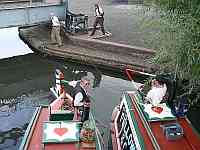 |
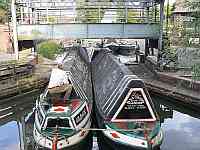 |
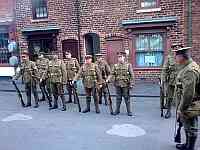 |
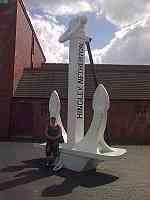 |
The bridge is wound up by hand so that President and Kildare can reverse into the Black Country Museum |
The army are put through their paces |
The Titanic's anchor was assembled in Birmingham |
|
After the Museum we decided to go down the Dudley number two Canal, which originally went through the Lapal Tunnel to Selly Oak, but since the tunnel's collapse in 1917 it has effectively terminated at Hawne Basin. It would probably not have surived had it not been for the thriving steel tube business of Stewart and Lloyds at Combeswood until 1967. We had not been there in Keeping Up, since having a hostile reception there on Thistle in 1988 and breaking down in Gosty Hill Tunnel, so we thought it was time to try again. The canal was in much better condition than we remembered it, and a series of imaginative mileposts and interpretation boards showed that considerable effort has been put into improving it.
Because of the narrow entrance it proved easiest to reverse into the basin and across to the service jetty, where we were made extremely welcome. We filled our tank with cheap diesel, walked all around the area, and spent an enjoyable evening as guests in the clubhouse. After our bad memories of 23 years ago, our opinion has completely changed and it is definitely on our "must revisit" list.
On the way back I took some pictures inside Gosty Hill Tunnel; it's not easy steering such a narrow tunnel and using a camera at the same time. With its narrow bore and varying roof heights it makes such a contrast with the later Netherton Tunnel, only a few miles away, which is wide and straight with dual towpaths to facilitate two-way traffic.
So we ended up back in Birmingham, and had intended to stay for a few days again but instead we beat a hasty retreat as the city erupted into riots. Instead we travelled back down to Alvechurch, pausing to spend a day at Cadbury's World which must be the perfect place to take a chocoholic grand-daughter!
Finally it was time to return home - leaving the boat at Braunston for blacking and to have its rudder finally straightened after our grounding on the Rochdale summit 2 years ago.
Now return to our CANALS HOME PAGE
| Go to Allan's Page | Part 1 - Boston and South Kyme | Canals Home Page | Part 2 - Manchester and Gloucester | Go to Deb's Page |
All pictures on this site are © Allan Jones unless otherwise stated